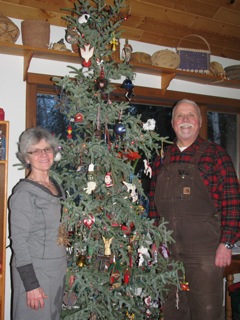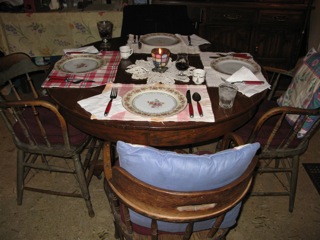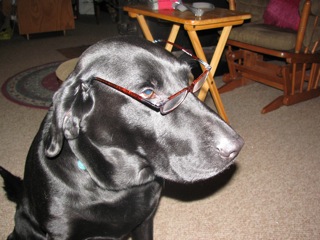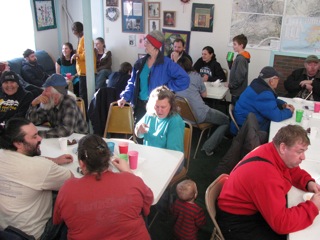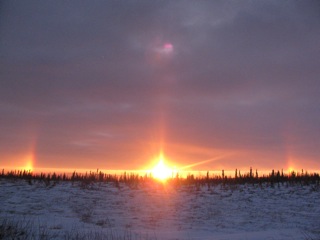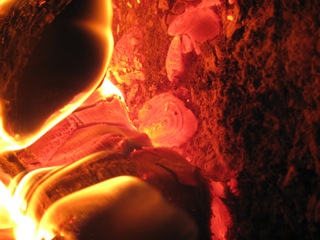The Alaska Report
More Alaska Reports
March 2013 | February 2013 | March 2012 | January 2012 | June, 2011 | February, 2011 | January, 2011 | December, 2009 | October, 2009
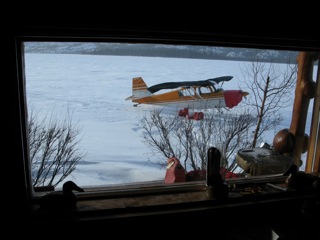 The Citabria aircraft on skis parked just outside our lodge window at Selby Lake. 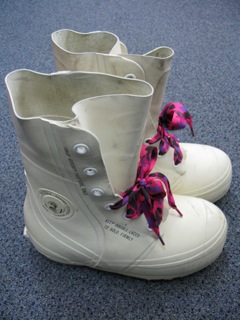 "Bunny Boots" began as military issue cold weather boots - with multiple layers of felt in the sole, and a "vapor barrier" for insulation. What "Classy" boot laces! 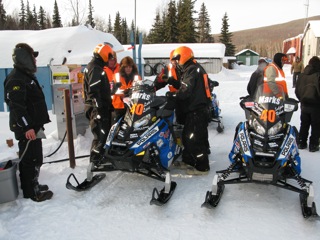 High performance snowmobiles "gasing up" at the Manley Hot Springs Trading Post 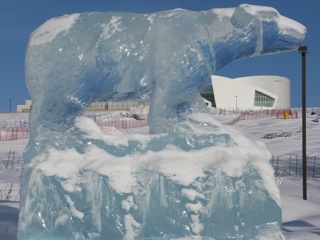 Ice carvings are a nice touch to Springtime in Fairbanks - particularly this carving of a polar bear at the University of Alaska Campus. 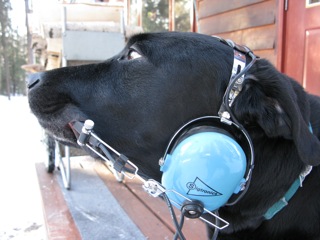 I can teach my black labrador retriever Bernt most anything . . . but he still has some difficulty talking on the radio. I can teach my black labrador retriever Bernt most anything . . . but he still has some difficulty talking on the radio. |
MARCH 15, 2013
The arrival of Spring in Alaska is symbolized by a variety of great events. One of the first is the Yukon Quest dog sled race from Whitehorse, Yukon Territory to Fairbanks, Alaska. Much of the race trail is down the Yukon River. The terrain in places is extremely rugged - and with high winds and snow over some of the mountain passes - conditions can become very rugged. Frostbite is not uncommon.
Both the "Quest" and the Iditarod dog sled race cover a distance of about 1,000 miles. This year, trail conditions were particularly good. The winning musher from Anchorage to Nome this year was Mitch Seavey - in a time of slightly over 9 days. That's about an average of 100 miles per day. Driver and dogs are indeed a "team" - and are all fine tuned athletes.
An offshoot of the Iditarod is the "Iron Dog" Race - also Anchorage to Nome - but on the return leg, the teams (2 snowmobilers, each with a machine), come through Manley Hot Springs, and finish in Fairbanks. These high performance machines can reach speeds at over 100 miles per hour on good flat trail. Tyler Huntington, a top contender, during pre-race practice hit an obstruction in the trail and crashed. With a broken pelvis, he was no longer to enter this year's race. A medical expense fund raiser was made for Tyler at the David Salmon Tribal Hall in Fairbanks.
Folks with a great variety of interests utilize the Iditarod Trail - "Iditabikers", runners, snowshoers, and others.
Springtime for many bush dwellers (remote area residents) - with longer days and better weather - means beaver trapping, hunting caribou for fresh meat, hauling wood for next winter, and traveling to visit friends and neighbors. Spring Carnivals will soon come up - with competitions of snowshoe racing, local dog sled racing, and many other fun activities. A Springtime feast or "potlatch" - featuring moose soup, smoked salmon, "Agutuk" (Eskimo Ice Cream), "Muktuk" (whale skin with blubber), and many other delicacies, are enjoyed by many.
Amid the celebrations and activities, I had two priorities on my list. Primary was to get the Polar Pumpkin ready for my upcoming flight to the North Pole. Proper maintenance is critical; so Mark and Nathan at Chena Marina Air Service were busy with their normal excellent service to the Pumpkin. Battery quality is the "heart" of my entire flight. Once again Concorde Battery came through with a new unit for the 24 Volt system. This year, through the air chemistry department at the University of Alaska Fairbanks, I am carrying an aethylometer on board the Pumpkin. With this instrument, I will be able to detect "Black Carbon" in the arctic atmosphere. Black carbon - i.e. soot - is emitted by a variety of factories, and other entities, throughout the world; and, amazingly enough, portions of this soot are found in the high arctic environment. The Arctic Council is an organization consisting of 8 circumpolar countries. Apparently Black Carbon is enough of an arctic issue that a special meeting of the Arctic Council was recently held in Sweden.
The second priority was to make a flight to our Peace of Selby Wilderness Lodge at Selby Lake with my smaller airplane - the Citabria - on skis. With any off airport first landing on a white surface such as the snow covered lake, one needs a sunny day with shadows to determine how heavily drifted the lake had become with the drifting snow over the winter. Fortunately I had good light conditions because the entire lake near the lodge was badly drifted with hard drifts. I found one small area in the extreme northeast corner of the lake where I could land safely - and then taxi over the drifts to park by the lodge. As a side benefit, I thought I'd bag a fresh caribou for meat - after staying overnight at least one night - but no caribou were to be seen. It's very much illegal to fly and hunt the same day airborne - for the good reason of giving the animal a fair chance to get away. The other very illegal activity in Alaska, with regard to hunting, is to not salvage all the meat from a hunt. Our moose population is quite low now due to predation by wolves. I did manage to see one beautiful gray wolf running through the deep snow - about a mile from a moose!
After the above priorities were accomplished - not without the able assistance of my wonderful wife Damaris - I was ready to once again head North to the Pole in the Polar Pumpkin.
Sometimes it seems that there just isn't enough time in the day to make my preflight preparations, do the flying, put the Pumpkin to bed for the night, AND get my web updates completed.
So please forgive me for the delays in updating this site.
FEBRUARY 12, 2013
Christmas 2012 has come and gone. It was another glorious season, spent mostly here in Manley Hot Springs. Damaris and I once again hopped on our snowmobile, and went out into the woods to cut our Christmas tree. It was such a nice one, that it's still gracing the living room. Our little log church was the center piece of the season - much comraderie, Christmas Carols, and Joy. We were invited up to a neighbor's house to bring in the New year with lots of good visiting, tasty food, and fire works.
Temperatures during January of 2012 were really cold. But this year the temps were much more mild. I don't think that we saw anything colder than 54 below zero Fahrenheit. When it warms up to 20 below or so, it feels like shirt sleeve weather! A freak ice storm did come through, and some of the animals in the bush are having a hard time. One of the local trappers was telling me that the ice crust was so thick that the moose were cutting their legs. I remember a similar situation in Svalbard, where the reindeer could not get to their food (lichens and moss) because of the ice encrusted habitat.
|
Art and Damaris with their decorated 2012 Christmas Tree.
Mr. Don DeLima's dining room table - used by famous polar explorer Roald Amundsen in Eagle, Alaska.
No doubt if a Black Labrador spends too much time on the computer, he experiences some eye strain.
The Manley Hot Springs community - of about 70 people - gets together every February for a Spring Ice Cream Social.
An Alaskan sunrise parhelion or "sun dog".
Besides the pleasant warmth of a wood stove, there is the beauty of the fire inside the stove also. |
I often comment on the wonderful hospitality that I have received during my travels through Canada. America is indeed so very fortunate to be neighbors with this wonderful country. While traveling through Inuvik, Yukon Territory the past two Springs, Mr. Bob Heath - and his lovely wife Lucy - looked after me with their most gracious kindness. With great sadness, I must report that Bob was killed in a terrible Twin Otter crash this past Antarctic season in the Queen Alexandra Range, while the aircraft was enroute from the South Pole for work with the Italians at Terra Nova Bay. The aircraft struck the 13,000 foot level of Mount Elizabeth; and is in such a position that it was unsafe to attempt retrieving the bodies yet this season. Climbers did retrieve the "black box" in the tail section of the airplane, so information relating to the cause of the crash may emerge. Bob was known to be one of the world's best Polar Pilots. Conceivably, extremely high winds and poor visibility may have been contributing factors.
Preparations continue for the flight of the Polar Pumpkin to the North Pole this April. The aircraft received its Annual Inspection with a clean bill of health; and I am now doing test flights. My science program continues to evolve. This year I will be carrying an Ethylometer owned by the University of Alaska Fairbanks. This instrument is used to detect black carbon or "soot" in the arctic atmosphere. The Earth's wind patterns may deposit black carbon thousands of miles from the source. Once again I will be using gelatin filters - from the University of Innsbruck - to sample microbial life in the arctic air.
As the worldwide importance of the Arctic is realized, more nations are scrambling to join the Arctic Council. Quite surprisingly, Singapore, India, and China - not exactly arctic nations - are attempting to join the Council. Why? As the sea ice of the Arctic Ocean melts - which it may do so on a grand scale - new transportation sea corridors will open, along with access to major natural resource business opportunities.
The Yukon Quest Sled Dog Race top finishers have just arrived in Fairbanks after their 950 mile run from Whitehorse, Yukon Territory. One of our local mushers, Brent Sass from Eureka, Alaska, came in 3rd. Besides being an experienced long distance dog sled driver, Brent is known for helping other mushers in need; and, this year was no exception when difficult conditions were encountered on Eagle Summit between Circle and Fairbanks. Some of the teams will have little rest before gearing up for the Iditarod Race - 1000 miles - from Anchorage to Nome.
As the days get longer, some folks head out with their dog teams or snowmobiles to various tundra lakes to catch a few fresh Northern Pike. After a winter of eating King Salmon and Chum Salmon, fresh Pike is a welcome change. Most folks nowadays use a motor powered ice auger to bore through the three to six foot depth of ice. "Jigging" is one of the techniques, with which a shiny spoon (lure) is attached to a short pole that's jerked up and down to give motion to the lure. In the early part of the winter - although not so commonly done these days - some families used under ice gill nets to catch pike and whitefish, for the family table and also as dog food for the winter.
Alexander Orlov, head of the expedition center for the Russian Geographic Society, has recently reported that the ambassadors of the Arctic Council nations will meet for talks at Ice Station Barneo in April. Barneo is established each year close to the North Pole; and is the base of operations for adventurers, scientists, and tourists. The camp is removed at the end of April. Another major news story from Russia reported that Rosneft, Russia's largest oil company, has recently signed a deal with Exxon Movil to explore Russia's Arctic Shelf in return for Russia's ability to acquire stakes in the Alaska gas field. Clearly the Arctic is becoming a much busier place these days.
Various polar expeditions are either in progress or planned. Ranulf Fiennes, from the UK - who has a longer "double barreled" name - is leading a winter crossing of the Antarctic. The name of the expedition is "The Coldest Journey". John Houston, from Chicago, will be co-leading an overland traverse of Ellesmere Island by dog team and ski this Spring. One of his goals is to make a documentary film of the island - and focus particularly on the life and activities of Otto Sverdrup. Although not a current "polar" expedition, Jennifer Murray - from the UK - will be doing a marathon run in the Atacama desert of Chile. Jennifer, with Colin Bodill, did a round the world helicopter flight a few years ago. Even though they crashed in Antarctic on the first attempt, they got another helicopter and ultimately completed the expedition. Pen Hadow, UK explorer, had planned a ski crossing of the Arctic Ocean via the North Pole this Spring; but Pen has recently canceled this expedition, and made notice of his retirement.
Several years ago, I had the great pleasure to interact with the Dickinson State University Theodore Roosevelt Scholars. On one occasion, I spoke with a collection of these students by satellite phone from Antarctica in the middle of a ground blizzard. More recently, I had the wonderful experience to do a teleconference with a group of students from the Rickover Naval Academy in Chicago. This institution was voted to be one of the best high schools in Chicago. In what sometimes appears to be a confused unstable world, it's heart warming to meet progressive, disciplined, hard working intelligent young people.
Valentines Day is just around the corner. So I shall wish you all - and your Sweethearts - a very Happy Valentines Day.
"We are each of us angels with only one wing, and we can only fly by embracing one another". - Lucretius
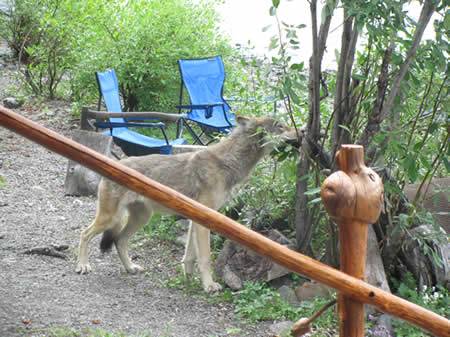
Extra tame wolf by the lodge porch
Red Currant Berries
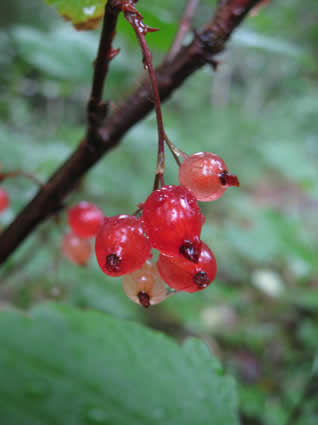
Grizzly bear hair in spruce pitch
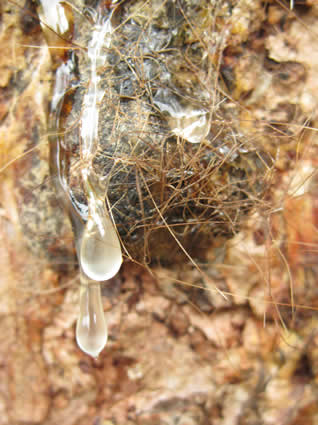
Purple Jacob's Ladder flower
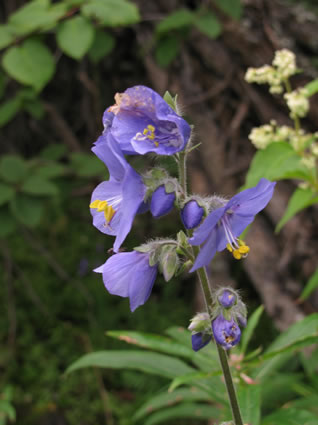
Step Fungi on a birch tree
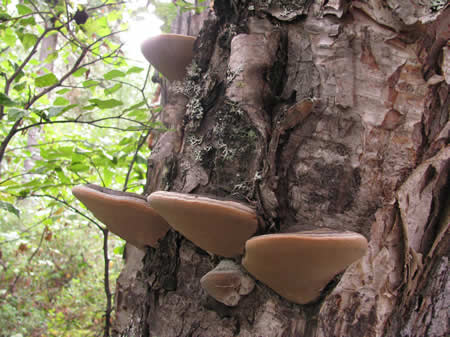
Nice bull moose
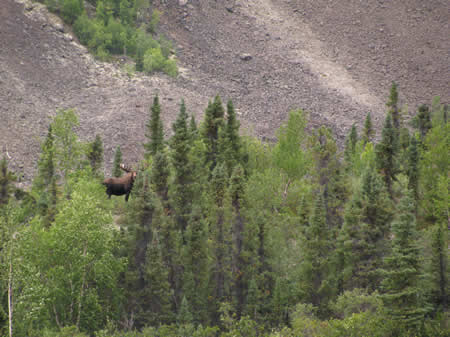
Flotilla of 4 common loons
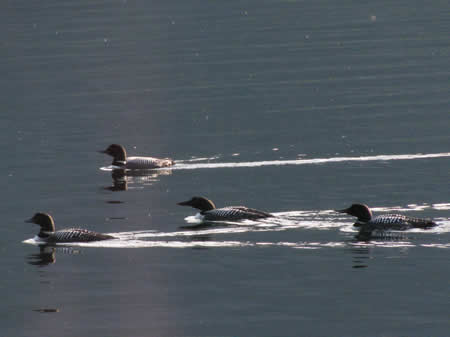
Freshly picked blueberries on the lodge porch
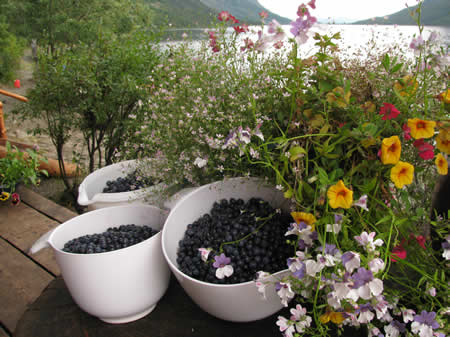
More grizzly bear hair in spruce pitch "rub tree"
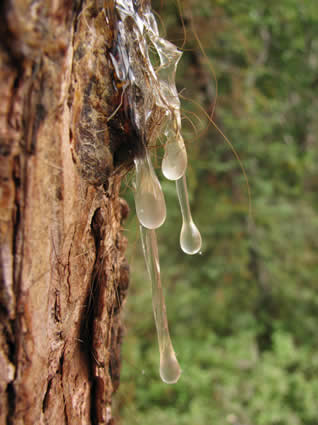
The Peace of Selby Lodge close to or in Selby Lake
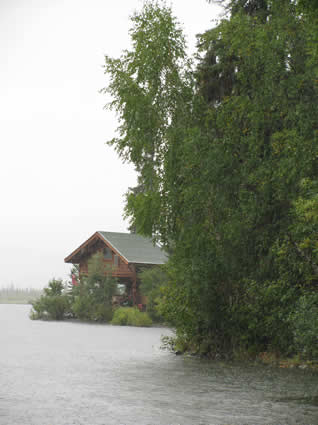
Teaching my black labrador retriever "Bernt" to drive the outboard motor
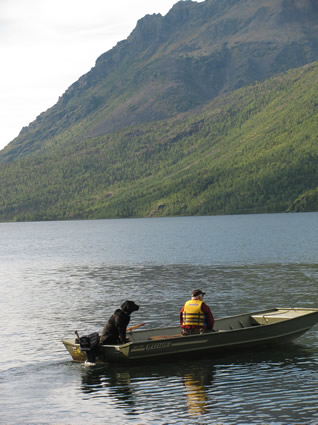
Low clouds over the mountains made flying very difficult
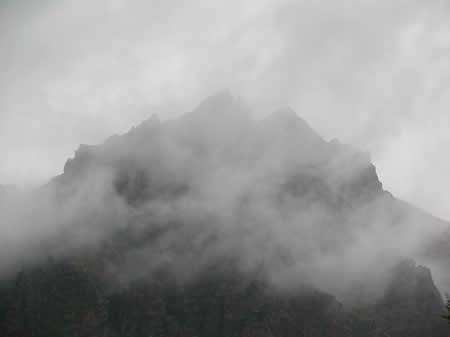
Rainbow over the Brooks Range and Selby Lake
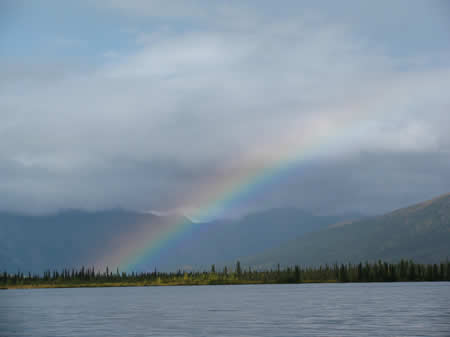
Light elegance of a dragon fly
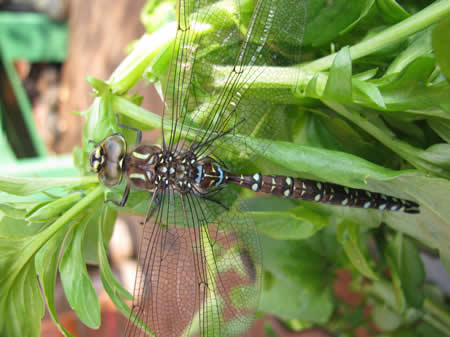
Wolf chewed lemonade pitcher retrieved from the woods
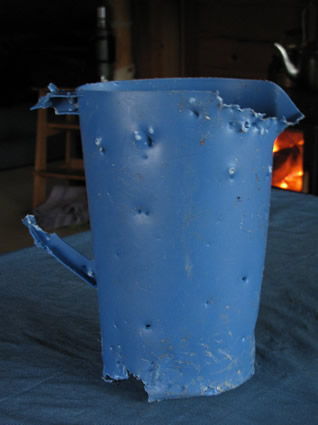
Quiet evening at Selby Lake
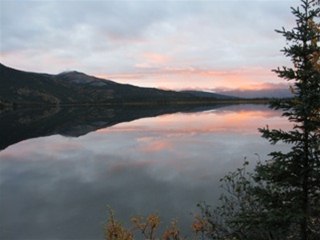
A happy couple
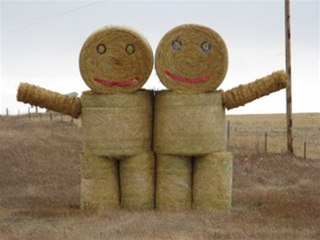
The Polar Pumpkin covered with snow on a cold icy winter night
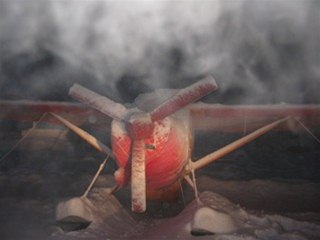
DECEMBER 14, 2012
"What good is the warmth of summer, without the cold of winter to give it sweetness."
- John Steinbeck, Travels with Charley: In Search of America
Summer of 2012 seems to have passed all too quickly.
Upon arriving back in Alaska with the Polar Pumpkin early last May, from my second attempt to land at the North Pole, weather conditions were such that lakes in the northern part of Alaska were iced in. The Tanana River, however, that runs by our house in Manley Hot Springs had a major ice jam - which then causes the river to run backwards, upstream, and right into our house. We had about a foot of water inside. What a mess! I can well empathize with the victims of Super Storm Sandy - of course on a much grander more devastating scale. Water flowed into our freezer; and the best way my wife Damaris could move the freezer to higher ground, was to "float the freezer" out the door!
Even though I have as yet not made it to the North Pole with the Polar Pumpkin, on my flight last year I did collect a considerable amount of data for NASA - i.e. 360 Gigabytes of hyperspectral imagery. This information is now being analyzed; and we will see what the feasibility is for taking this same equipment on another High Arctic flight in the Polar Pumpkin.
It's a particular pleasure for me as a pilot to combine the varied aspects of aviation, science, and the remote wilderness. Another group with whom I've been working are particularly interested in Global Warming and Climate Change from the perspective of methane (CH4) emissions, along with other Greenhouse Gases such as carbon dioxide. The Polar Pumpkin and I did some research in this regard during the Arctic spring; and then more follow up work was done by a student intern from California Polytechnic University over the summer in the Brooks Range. Methane seeps - from thawing permafrost - and from oceanic methane hydrate vents - are predicted to play a prominent roll in climate change.
Once again, Everts Air in Fairbanks graciously provided a safe hangar for the Polar Pumpkin over the summer. Hail is usually not problem in Interior Alaska; but it can happen, and the last thing I want is for the Pumpkin to get hammered by a thunderstorm.
My summer flying then turned to a Cessna 180 float plane that I use in support of our wilderness lodge business at Selby Lake (www.alaskawilderness.net). It was a very difficult summer. The weather was particularly rainy, with many days of low cloud, that limited flying possibilities - for logistic operations, grocery and supply flights, and for guests to go where and when they wanted. In one case, we wanted to fly through the Brooks Range passes to view the migration of the Western Arctic Caribou Herd (500,000 animals); but that was completely impossible due to the bad weather. It rained enough, such that there was water up to the second step of the porch going into the Lodge. Fortunately, as a result of the deluge, forest fires were not a major problem this season. There were one or two forest fires about 20 miles south of our lodge; but they didn't spread much, and were quickly put out.
I sometimes tell friends that there is no need to go to a zoo when there are people to watch. Waiting in airport lounges, for example, offer many opportunities for "people watching" - and also a chance to meet folks from many parts of the world.
Living in the wilderness provides the double treat of wildlife viewing as well. From our lodge porch swing, we can see grizzlies, black bears, wolves, wolverine, otter, and other arctic wildlife. This summer, we had a very unusual opportunity of viewing a wolf up particularly close. So close, that I was worried that it may end up attacking one of the lodge staff or a guest. In conferring with professional wildlife biologists at the Alaska Department of Fish and Game, I generally accepted their suggestion that the wolf was probably an adolescent establishing a territory. Anyway, this single wolf came by the lodge porch steps on several occasions. Our black Labrador Bernt gave his "bad dog bark"; which didn't phase the wolf one bit. In fact, the wolf was probably thinking, "come on black dog, make my day". My wife Damaris sometimes put a 2 quart container of lemonade in the shallow lake water to cool the lemonade a bit (water temp is about 52 degrees Fahrenheit). Our friendly wolf sniffed the container - and then ran off into the woods, carrying the full 2 quarts of lemonade - by the handle, no less! We ultimately found the container . . . chewed to bits.
Mother Nature is in Supreme control of our lives - no matter where we live - but it's perhaps most obvious in the remote wilderness of bush Alaska. In late summer, a Survival School Instructor from Northern Wisconsin arrived on the Ambler River - about 40 miles west of our lodge - with the idea of spending "freezeup" in a friend's log cabin - and then would walk from the cabin about 30 miles into the Eskimo village of Kobuk by November 11, to catch his return flight to the "Lower 48". When he did not arrive on schedule, a search began. Alaska State Troopers, local folks, and friends searched the moutains and valleys of the Brooks Range for 13 days. Nothing was found of this individual. The Ambler River is a relatively fast and channel braided stream, with areas of thin ice. Some folks surmise that this young man broke through the ice, and was sucked under by the current. I broke through the ice during mid winter, many years ago; and had it not been for my buddy from North Dakota pulling me out, I wouldn't be here today. Mother Nature, in supreme control, deserves Supreme respect.
All of us in casual conversation seem to enjoy comparing weather reports from our various locales - even in Alaska - when folks like "one-upmanship" in temperature reports. So far this winter here in Manley Hot Springs, we've had temperatures down to 58 degrees below zero Fahrenheit. I met a guy in Fairbanks who said he had -62F. In any case, it's the time of the year when an "Arctic High" pressure system can bring cold conditions. Geese go South for a good reason. There is, however, a flock of ducks - that a local guy feeds - on the Chena River in Fairbanks, close to the warm water discharge from the power plant. The good news is that we're gaining a few minutes of daylight each day - now light by 1015 hrs. and dark by 1620 hrs.
The Polar Pumpkin is doing well. I recently dug the aircraft out of a snow bank at its parking spot of Fairbanks International Airport. After doing a thorough preflight - and cycling the wheel skis - I flew it to my mechanics for its Annual Inspection. Not only is this inspection a legal requirement to keep an airplane "Airworthy", it also makes good sense. I'm particularly fortunate to have a couple excellent mechanics that have worked on the Pumpkin in the past, and know it very well. If the Pumpkin passes the inspection with no major problems, I will be doing some test flights in the next few weeks. In the mean time, I am organizing my science and logistics.
**NOTE: The primary news that I want to share with you folks is that I will again be attempting to land the Polar Pumpkin at the Geographic North Pole during this coming April 2013.
I am forever grateful for the support of so many folks, in believing in my science program - and that I will get the Polar Pumpkin to the Pole.
**WELCOME ON BOARD POLAR FLIGHT 90 IN 2013!
Quotes that I would like to share:
"In wilderness is the preservation of the world". -Henry David Thoreau
"Wilderness is not a luxury but a necessity of the human spirit." - Edward Abbey
"In wilderness I sense the miracle of life, and behind it our scientific accomplishments fade to trivia." - Charles Lindbergh
"To the lover of wilderness, Alaska is one of the most wonderful countries in the world." - John Muir
"It does not matter how slowly you go as long as you do not stop." - Confucius
"Dripping water hollows out a stone, not through force but through persistence."
-Ovid

